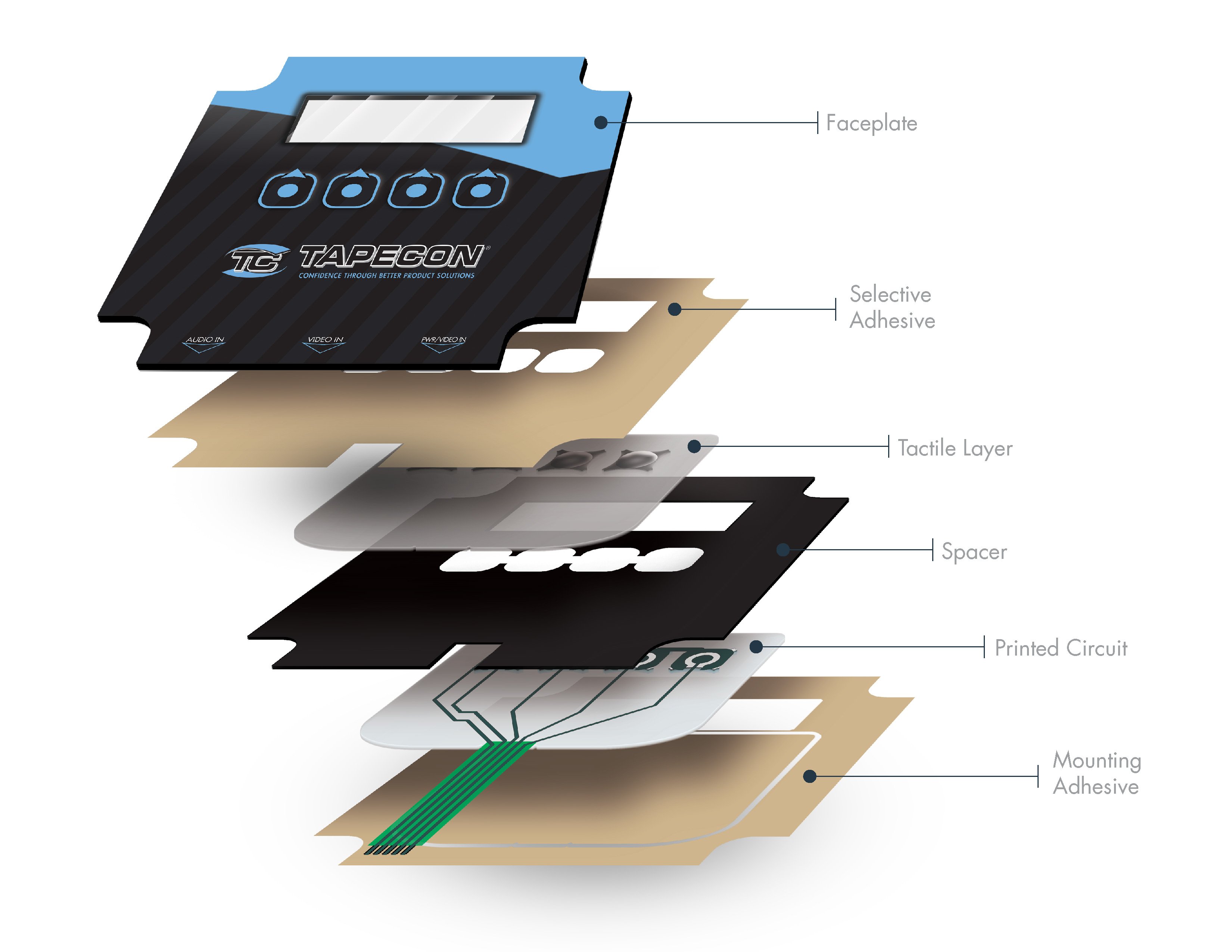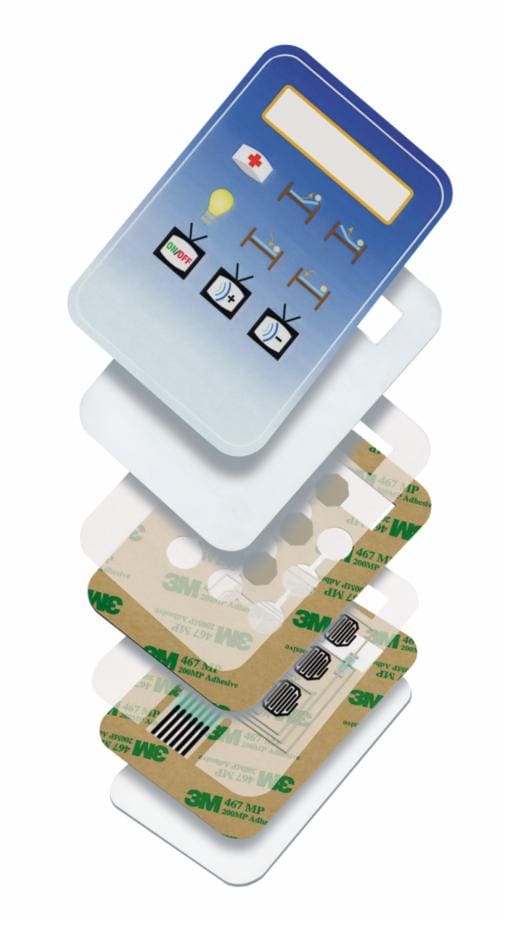Recognizing the Importance of Membrane Layer Change in Modern Electronics
Membrane layer buttons are essential elements in modern-day digital gadgets. They use a mix of capability and style that boosts customer communication. Their resilient and lightweight nature makes them suitable for different applications. As sectors advance, the need for personalization and progressed functions grows. Recognizing how membrane switches add to development discloses their value in forming the future of electronic devices. What lies in advance for this technology?
The Fundamentals of Membrane Layer Change Technology
Although usually neglected, membrane layer switch innovation plays a vital duty in the modern electronics landscape - membrane switch. These tools, composed of numerous layers, offer as interface for various electronic items, ranging from household appliances to medical equipment. A normal membrane button is composed of a graphic overlay, a spacer layer, and a circuit layer, which are meticulously assembled to develop a practical interface.When stress is put on the overlay, the circuit layer is finished, enabling signals to be transferred to the gadget. This innovation is understood for its flexibility, enabling customization in capability, shape, and design to fulfill particular individual needs. In addition, membrane switches are lightweight and thin, making them suitable for applications where space is a premium. Their longevity and resistance to ecological aspects additionally boost their charm, guaranteeing they can withstand rough conditions while keeping performance. Overall, membrane layer button modern technology is integral to producing easy to use and reliable electronic devices

Key Benefits of Membrane Changes
Membrane layer switches deal a number of key benefits that make them a recommended choice in various electronic applications. Their style permits for a small kind variable, enabling manufacturers to produce lightweight and smooth devices. Furthermore, membrane layer switches are immune to dust, dampness, and chemicals, which improves their sturdiness and durability sought after settings. The tactile comments offered by these buttons can boost user experience, making them simple and user-friendly to operate.Furthermore, membrane layer switches can be customized with varied graphics and shades, enabling for distinct branding opportunities. The production procedure is generally cost-efficient, specifically for high-volume manufacturing, as it minimizes setting up time and streamlines design. Membrane switches over call for marginal maintenance, adding to reduced general functional costs. These benefits emphasize their expanding appeal in modern-day electronic devices, where integrity and user-friendly interfaces are necessary.

Applications Across Numerous Industries
The flexibility of membrane switches enables their extensive adoption throughout different sectors. In the medical area, they are generally utilized in analysis devices and client surveillance systems, using a durable user interface immune to contaminants. The auto industry uses membrane switches for control panel controls, boosting user experience with sleek designs that withstand rough conditions. In customer electronic devices, they function as control board for tools such as microwaves and coffee manufacturers, supplying a straightforward user interface that is easy to clean. The aerospace field utilizes membrane layer buttons in cabin controls, where integrity and space effectiveness are paramount. Furthermore, the commercial field leverages these buttons in equipment and control systems to assure durable procedure sought after environments. This broad series of applications emphasizes the versatility of membrane buttons, making them important components in enhancing capability and individual communication across varied technological landscapes.
Modification and Layout Versatility

Future Patterns in Membrane Change Growth
Arising patterns in membrane layer button development show a growing focus on boosted functionality and combination with clever innovations. As consumer demand for much more sophisticated digital devices increases, suppliers are concentrating on producing membrane switches over that not just serve standard functional functions yet also include functions like touch sensitivity, backlighting, and haptic feedback.Furthermore, improvements in materials are expected to enhance toughness and ecological resistance, making membrane layer changes ideal for diverse applications in sectors such as medical care, auto, and consumer electronics. The integration of capacitive touch technology is most likely to come to be a lot more prevalent, permitting sleeker layouts and enhanced user interfaces. membrane switch.Additionally, the surge of the Web of Things (IoT) is motivating the advancement of membrane changes that can communicate wirelessly with various other gadgets, boosting interconnectivity. On the whole, the future of membrane layer button i was reading this innovation appears promising, driven by technology and the quest of straightforward options
Frequently Asked Questions
How Do Membrane Changes Contrast to Conventional Mechanical Switches?
Membrane layer buttons, being much more space-efficient and using a sleek layout, comparison with traditional mechanical switches that provide tactile responses. The former usually feature adjustable graphics, while the latter normally ensure sturdiness and integrity in numerous applications.
What Products Are Typically Made Use Of in Membrane Layer Switch Over Production?
Membrane layer switches are normally generated utilizing products such as polyester, polycarbonate, and published conductive inks. These materials supply responsiveness, durability, and versatility, making them appropriate for numerous applications in electronic devices and interface.
Can Membrane Changes Be Repaired or Recycled?
Membrane switches can frequently be repaired, particularly if minor issues develop, such as glue failure or surface damage. However, full reuse is normally restricted as a result of use and possible degradation of materials gradually.
Exactly How Do Ecological Elements Affect Membrane Change Efficiency?
Ecological factors, such as temperature level, humidity, and exposure to chemicals, greatly affect membrane button performance. Severe conditions can bring about destruction, influencing responsiveness and durability, inevitably endangering the functionality of the gadget in different applications.
What Is the Regular Life Expectancy of a Membrane Switch?
The normal life-span of a membrane layer button generally varies from 1 to 5 million actuations, relying on aspects such as usage regularity, environmental conditions, and the products made use of in manufacturing, impacting durability and efficiency long life. A normal membrane layer button is composed of a graphic overlay, a spacer layer, and a circuit layer, which are diligently assembled to develop a practical interface - membrane switch.When stress is applied to the overlay, the circuit layer is completed, permitting signals to be transmitted to the device. The tactile feedback offered by these switches can enhance customer experience, making them easy and user-friendly to operate.Furthermore, membrane layer buttons can be personalized with diverse graphics and shades, enabling for unique branding possibilities. As consumer need for extra innovative digital gadgets boosts, producers are focusing on developing membrane switches over that not just serve fundamental functional functions yet likewise incorporate functions like touch sensitivity, backlighting, and haptic feedback.Furthermore, innovations in materials are anticipated to boost toughness and environmental resistance, making membrane layer changes appropriate for varied applications in industries such as medical care, automobile, and customer electronics. The assimilation of capacitive touch innovation is likely to end up being a lot more prevalent, allowing for sleeker styles and enhanced customer interfaces.Additionally, the rise of the Internet of Points (IoT) is triggering the development of membrane layer switches that can connect wirelessly with other gadgets, improving interconnectivity. Membrane switches, being a lot more space-efficient and supplying a streamlined layout, contrast with standard mechanical switches that offer tactile responses